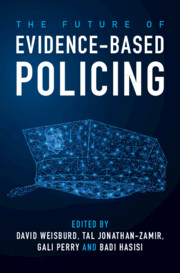Book contents
- The Future of Evidence-Based Policing
- The Future of Evidence-Based Policing
- Copyright page
- Contents
- Figures
- Tables
- Contributors
- Editors
- 1 The Future of Evidence-Based Policing
- Part I Taking Stock of Evidence-Based Policing
- Part II The Evidence for Evidence-Based Policing
- 5 A Review of Systematic Reviews in Policing
- 6 What Do We Know about Proactive Policing’s Effects on Crime and Community?
- 7 Rethinking the Role of the Community in Proactive Policing
- Part III Innovations in Tools of Evaluation and Assessment
- Part IV Challenges to the Implementation of Evidence-Based Policing
- Part V The Practitioner’s Perspective
- 17 Conclusions
- Index
- References
6 - What Do We Know about Proactive Policing’s Effects on Crime and Community?
Drawing Conclusions from a National Academies of Sciences, Engineering, and Medicine Report
from Part II - The Evidence for Evidence-Based Policing
Published online by Cambridge University Press: 01 June 2023
- The Future of Evidence-Based Policing
- The Future of Evidence-Based Policing
- Copyright page
- Contents
- Figures
- Tables
- Contributors
- Editors
- 1 The Future of Evidence-Based Policing
- Part I Taking Stock of Evidence-Based Policing
- Part II The Evidence for Evidence-Based Policing
- 5 A Review of Systematic Reviews in Policing
- 6 What Do We Know about Proactive Policing’s Effects on Crime and Community?
- 7 Rethinking the Role of the Community in Proactive Policing
- Part III Innovations in Tools of Evaluation and Assessment
- Part IV Challenges to the Implementation of Evidence-Based Policing
- Part V The Practitioner’s Perspective
- 17 Conclusions
- Index
- References
Summary
In this chapter we summarize the findings of the National Academy of Sciences, Engineering, and Medicine report on proactive policing, focusing on impacts on crime and communities. We begin the paper with a description of how proactive policing was defined in the report, and a summary of the wide scale use of proactive policing approaches in American police agencies. We then turn to summaries of the evidence on crime control and community outcomes. The report concluded that there was sufficient scientific evidence to support the adoption of many proactive policing practices. We argue that successful prevention programs rely on greater focusing of police resources, and expansion of the tools of policing (for crime prevention). The Committee also found that crime prevention outcomes can often be obtained without producing negative community reactions, and that some community-based strategies have begun to show evidence of improving the relations between the police and public. In concluding, we argue that future proactive policing programs should seek to maximize both crime prevention and positive community outcomes and suggest how this can be done given the report’s findings.
Keywords
- Type
- Chapter
- Information
- The Future of Evidence-Based Policing , pp. 107 - 125Publisher: Cambridge University PressPrint publication year: 2023

